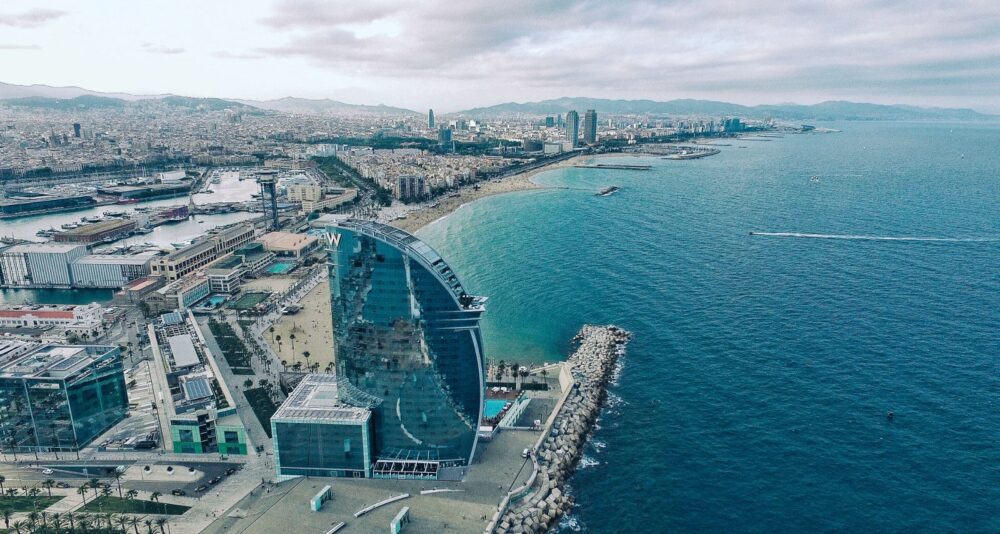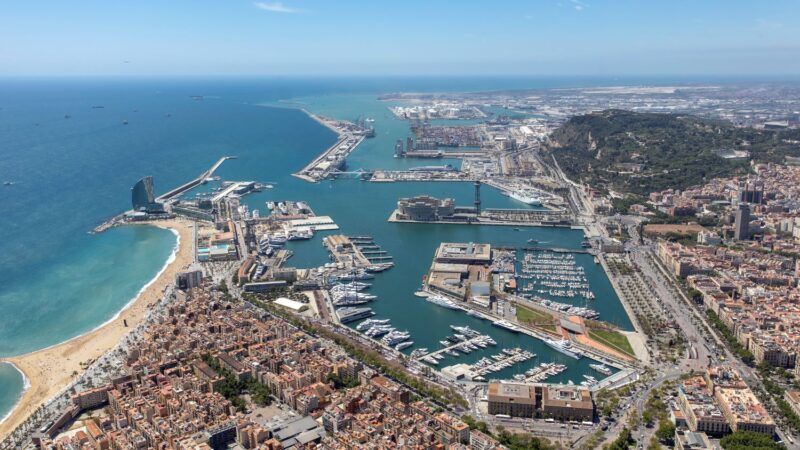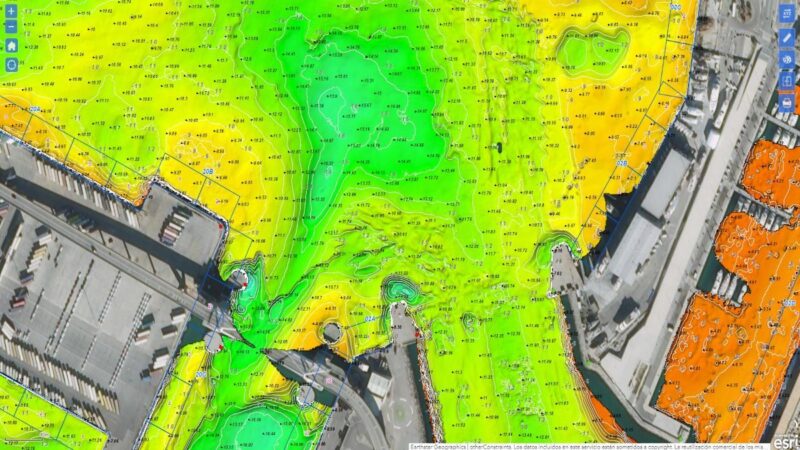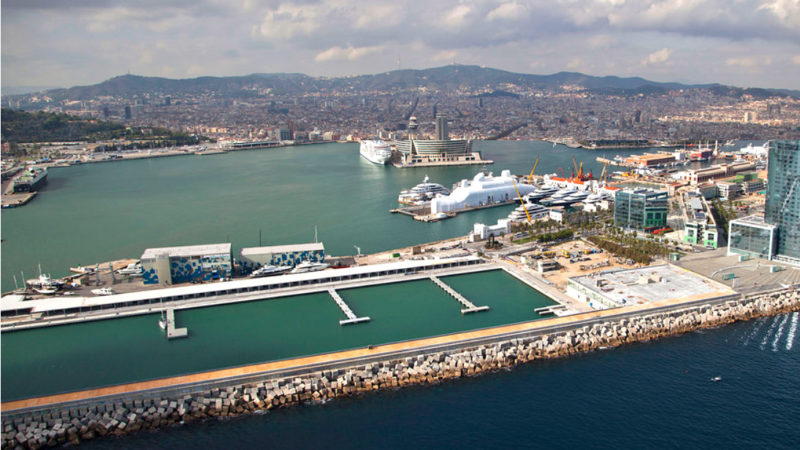 Aerial photography of Barcelona, where the coexistence of different areas of Port de Barcelona with the city is noticeable [Image by Benjamin Gremler]
Aerial photography of Barcelona, where the coexistence of different areas of Port de Barcelona with the city is noticeable [Image by Benjamin Gremler]
Impact And Sustainability Of City Ports
Ports, as points that connect different territories, are born out of and make up part of the large cities around them, which in turn act as a meeting point for the social and economic activity of the inhabitants and their surroundings. With industrialisation, this link is no longer so clear, and ports began an expansion process that separated them from the city centre. These processes became consolidated with globalisation, with goods transport and the tourist industry taking centre stage, requiring more space and more specialisation.
 Aerial photography of Barcelona, where the coexistence of different areas of Port de Barcelona with the city is noticeable [Image by Benjamin Gremler]
Aerial photography of Barcelona, where the coexistence of different areas of Port de Barcelona with the city is noticeable [Image by Benjamin Gremler]
However, there are many cities that have not only not turned their backs on their origins as a port city, but that take pride in it and showcase it as part of their identity. This the case of a wide variety of cities like Barcelona, Amsterdam, Rotterdam and Marseille, to name just a few in Europe, which have been able to integrate the port activity and environment into residents' urban life. The port is considered both a driver of economic activity and a place for cultural and recreational activities for residents. Although it is a challenge for city ports to strike a balance between the different uses.
Advantages and direct costs of living in a port city
The benefits of a port are well-established: lower logistics costs for companies and consumers, better local and regional infrastructure and, of course, more direct and indirect jobs. In Barcelona's case, it can be said that there wouldn't be a metropolis of four and a half million people if there wasn't a facility like the port that made it possible for all of these residents to be rooted in the territory and work competitively on a global level.
In this regard, having a facility like the port is key. "What would happen with the population whose jobs depend on the port industry?" wonders Pedro Arellano, Deputy General Manager at Port of Barcelona. "These workers would have to go live somewhere else or, for example, the factories for important clusters (automotive, fashion, pharmacy, etc.) would be in other places. To ensure that our population remains rooted in this territory, there are several elements that are positively tied to the existence of a port with the dimensions and global competitiveness of the one in Barcelona."
The Port of Barcelona makes it easier for citizens to work competitively on a global scale but it also helps them feel rooted in the territory.
The direct investment that a port requires is clear: the cost of a terminal, rail line or road, etc., but how do you value the costs and benefits of having globally competitive facilities? What about its externalities? What impact does contamination from these critical facilities have on people's health? What other lifestyle and employment options should be created so the population of this metropolis can feel rooted in its territory? "We have to ask ourselves the hard questions so we can find answers that are not simple," says Pedro Arellano. "We have to be realistic in finding answers. If that realism tells us that we are doing well, or that we are on the right track, great. But if that isn't the case and it shows there is still a long road ahead, then we have to re-prioritise and get to work."
To face this type of dilemma and put in place projects to change and improve the situation, it is important to be well aware of what happens both inside and outside of the port. The Port of Barcelona Sector Sustainability Plan aims to tackle this type of issues. Cruise ships, for example, have problems today with emissions (mainly due to the fact that the ships have a long lifespan), although new cruise ships have evolved a lot and already have much lower emissions. However, while there is still room for improvement in terms of emissions, the water treatment systems on latest generation cruise ships are excellent, resulting in water that could even be drinkable again. "Many other industries whose waste ends up in rivers or seas could take a leaf out of their book in terms of the hard work and efforts the cruise ship industry has put into water treatment," says Pedro Arellano.
Tackling the complexity of a sector like the port sector requires a broad point of view, integrating highly diverse realities and expectations. This is the only way to face and address current challenges and dilemmas. Doing all of this will allow us to create a port that is sustainable in the long term.
To achieve this, the port community decided to develop the joint initiative mentioned previously: the Sector Sustainability Plan. Today, being able to address the range of expectations is not only a question of having the multiple indicators and sources of operational information available in a critical facility like a port, but also requires analysing and developing another type of initiatives that were historically less tangible.
Currently, for example, we know that more than 50% of the organisations analysed in the Port of Barcelona are already using tools to strive for excellence and are committed to sustainability. This means having a broad base of organisations that look beyond short-term profit. If we compare this percentage with that for all the companies in the country, it is clear that the organisations in the port community are well above average with regard to integrating these considerations into their daily tasks.
A port within the urban grid
Beyond the economic indicators and environmental issues, city ports have to come up with different ways to relate to residents. In this regard, for Arellano, the Port of Barcelona "tries to eliminate the border with the metropolis and is committed to initiatives that foster permeability between the port and the residents," that forge bonds between them. This requires "new methods of collaboration" that open up communication between the port community and all of the Port interest groups.
This communication is always seen as a two-way street: the port has to explain clearly and simply what happens there and what its values are. At the same time, residents should feel the port is part of the city and, therefore, that it is just as much theirs as any park or square is. "Having this sort of influence on the metropolis involves mapping the interest groups, delving deeper into their expectations and needs and, of course, getting to work with all of this information," says Arellano.
To do so, it is crucial to create what he calls "interrelations spaces", which can be physical or virtual, and also temporary or more permanent, always taking into account the three focal points that ensure the port's sustainability: financial, social and environmental. So, the port is home to cultural, sporting and recreational events for city residents (from Chinese New Year festivities to the starting point for the city's King's Day parade to name just a few examples), as well as trade fairs (like the Barcelona International Boat Show). Likewise, we also find environmental initiatives, which despite being intangible have a direct impact on society as a whole. In this regard, the energy transition towards less contaminating combustible fuels like LNG, the commitment to electric mobility and efforts to conserve the habitat of native species are part of the battery of measures to minimise the port's environmental impact on the city.
Beyond economic metrics and environmental issues, urban ports should consider different ways of relating to citizens.
![The Portal de la Pau building, which had hosted the headquarters of the Port Authority of Barcelona, will be transformed into an Interpretation Center for the port [Image by Fred Romero]](https://piernext.portdebarcelona.cat/wp-content/uploads/2018/11/portalpau-1024x652.jpg)
'This is a Port' initiative
The immediate future requires formalising these "interrelations spaces" in a specific environment. This is the goal of the future Port of Barcelona dissemination centre, which will be located in a historical, iconic port building, Portal de la Pau, built in the early 20th century.
Under the name 'This Is A Port' ('Esto es un puerto'), the space will become a tool for communication, dissemination and entertainment based on the activities of the Port of Barcelona: "It will be a one-of-a-kind space for dialogue between the port community and interest groups. The goal is to get followers, residents who are proud of their port and, therefore, believe it is crucial to share its essence," explains Arellano. "The centre is the physical representation of this strategy that is shared by all those involved in the activity of the port."






